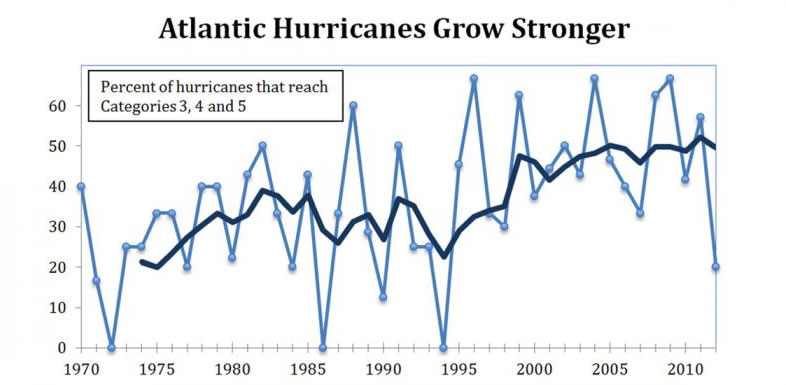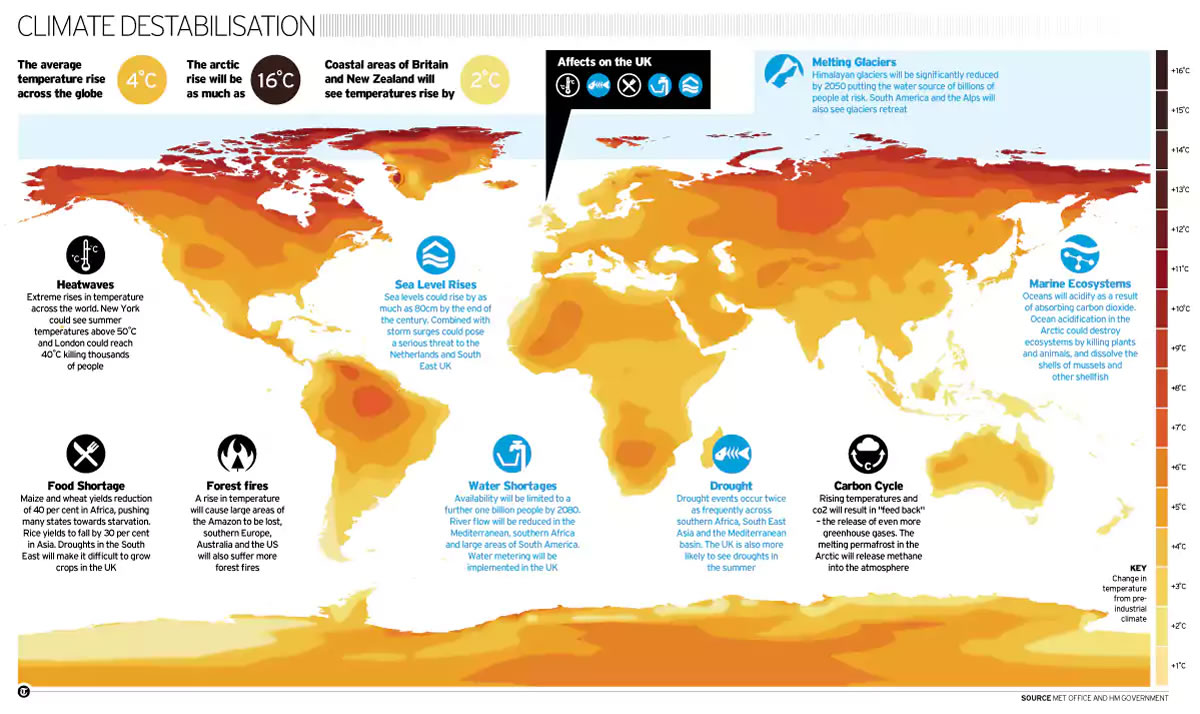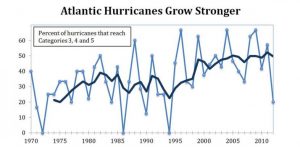Myth: Climate change will have some benefits. Climate alarmists need to take a breath and weigh the pros and cons of global warming.
Fact: The cons outweigh the pros by a large margin, and the cons are far more extreme in nature. This has been understood for years. Many of the alleged benefits are based on a misconception of how global warming will actually affect out atmosphere and oceans.
Global Warming: Pros and Cons
There are those who claims that climate change will have some positive impacts on the Earth, and that this needs to be weighed against the negative outcomes. However, the positive/negative outcomes have been long since compared, and the concern over climate change is due to the overwhelming negative results.



One such example: CO2 is GOOD for plant, and we should weigh this and other positive aspects against their negative counterparts.
The effects have already been published
Here are some snippets from a 2008 IPCC Paper:
However, the large-scale implications of CO2 –water interactions (i.e., at canopy, field and regional level) are highly uncertain. In general, it is recognised that the positive effects of elevated CO2 on plant water relations are expected to be offset by increased evaporative demand under warmer temperatures.
Many recent studies confirm and extend TAR findings that temperature and precipitation changes in future decades will modify, and often limit, direct CO2 effects on plants. For instance, high temperatures during flowering may lower CO2 effects by reducing grain number, size and quality (Thomas et al., 2003; Baker et al., 2004; Caldwell et al., 2005). Likewise, increased water demand under warming may reduce the expected positive CO2 effects.
Impacts of climate change on irrigation water requirements may be large. A few new studies have further quantified the impacts of climate change on regional and global irrigation requirements, irrespective of the positive effects of elevated CO2 on crop water-use efficiency.
From a paper by David Pimentel (from 1993):
Changes in the world’s climate will bring major shifts in food production.[2] In some places, temperatures will rise and rainfall will increase; in others, rainfall will decrease. In addition., coastal flooding will reduce the amount of land available for agriculture.[3]



In general, food crops are sensitive to climate change. Such change, which affects soil temperature and moisture levels, also determines the vitality of both beneficial organisms and pests.
Due to the enormous uncertainties surrounding global climate change, estimates of cropland reductions vary widely–from 10 to 50 percent.[4] But this much is clear: global warming is likely to alter production of rice, wheat, corn, soybeans, and potatoes–staples for billions of people and major food crops in both North America and Africa.
Nevertheless, to this day there are politicians and political pundits floating the idea that climate change/global warming will be good for plants, often citing that “CO2 is good for plants.”
The effects of Climate Change are not linear
When it comes to understanding the negative impacts of climate change, our basic intuition causes us to assume that its effects will be linear, and this is not the case. It’s often assumed that it simply means a few basic trade offs like less ski reports but more golf courses. Mexico will be a little hotter but Canada will be more tolerable. Agriculture will become possible in new parts of the world. In reality the effects are not so linear. The atmosphere and oceans are complicated and contain countless interlinking systems and feedback loops. The effects of temperature increase will not be some blanket effect but will set off events that will affect regions differently.
Weather events will become more extreme, making agriculture even less dependable. The world’s breadbaskets are already few and far between and extreme weather events will make them less able to provide food for a growing world population.
Human populations have largely set up across coast lines based on a relatively predictable pattern (which has held steady for 10,000 years) of flooding and other factors. Increased water vapor and hotter oceans will mean stronger hurricanes and flooding (events like Katrina, Sandy, and Irma were once fewer and further between). This means danger to the coastal population, a massive refugee crisis, and ultimately trillions of dollars in damage.

Why the military is concerned with Global Warming
When Bernie Sanders referred to climate change as a security threat, many pundits were quick to portray this is a ludicrous statement. However, the military is concerned that the effects of climate change will lead to border wars as coastal lines, water availability and resource maps are redrawn, as well as dangers to its own installations around the world.
The Pros and Cons of Climate Change
Here is an exhaustive list of the “pros and cons” of climate change, courtesy of Skeptical science. Contrary to what deniers imply, the positives and negatives of climate change been long since understood. See full list here.
Agriculture
Positive agricultural outcomes
- Improved agriculture in some high latitude regions (Mendelsohn 2006)
- Increased growing season in Greenland (Nyegaard 2007)
- Increased productivity of sour orange trees (Kimball 2007)
Negative agricultural outcomes
- Decreasing human water supplies, increased fire frequency, ecosystem change and expanded deserts (Solomon 2009)
- Decline in rice yields due to warmer nighttime minimum temperatures (Peng 2004, Tao 2008)
- Increase of Western United States wildfire activity, associated with higher temperatures and earlier spring snowmelt (Westerling 2006)
- Encroachment of shrubs into grasslands, rendering rangeland unsuitable for domestic livestock grazing (Morgan 2007)
- Decreased water supply in the Colorado River Basin (McCabe 2007)
- Decreasing water supply to the Murray-Darling Basin (Cai 2008)



Economic
Positive economic outcomes
- Increased cod fishing leading to improved Greenland economy (Nyegaard 2007)
Negative economic outcomes
- Economic damage to poorer, low latitude countries (Mendelsohn 2006)
- Billions of dollars of damage to public infrastructure (Larsen 2007)
- Reduced water supply in New Mexico (Hurd 2008)
- Increased risk of conflict (Zhang 2007) including increased risk of civil war in Africa (Burke 2009)
- Drop in primary productivity due to unprecedented warming at Lake Tanganyika (Tierney 2010)
Environment
Positive environmental outcomes
- Increased vegetation activity in high northern latitudes (Zhou 2001)
- Increase in chinstrap and gentoo penguins (Ducklow 2006)
- Increased plankton biomass in the North Pacific Subtropical Gyre (arguably ENSO/PDO might be dominant influence) (Corno 2006)
- Recent increase in forest growth (McMahon 2010)
- Bigger marmots (Ozgul 2010)
- Increased Arctic tundra plant reproduction (Klady 2010)
Negative environmental outcomes
- Rainforests releasing CO2 as regions become drier (Saleska 2009)
- Extinction of the European land leech (Kutschera 2007)
- Decrease in Adélie penguin numbers (Ducklow 2006)
- Disruption to New Zealand aquatic species such as salmonids, stream invertebrates, fishes (Ryan 2007)
- Oxygen poor ocean zones are growing (Stramma 2008, Shaffer 2009)
- Increased mortality rates of healthy trees in Western U.S. forest (Pennisi 2009)
- More severe and extensive vegetation die-off due to warmer droughts (Breshears 2009)
- Increased pine tree mortality due to outbreaks of pine beetles (Kurz 2008, Bentz 2010)
- Increased risk of coral extinction from bleaching and disease driven by warming waters (Veron 2009, Carpenter 2008)
- Decline in lizard populations (Sinervo 2010)
- Reduction in global phytoplankton (Boyce 2010)
- Decline in global net primary production – the amount of carbon absorbed by plants (Zhao 2010)






